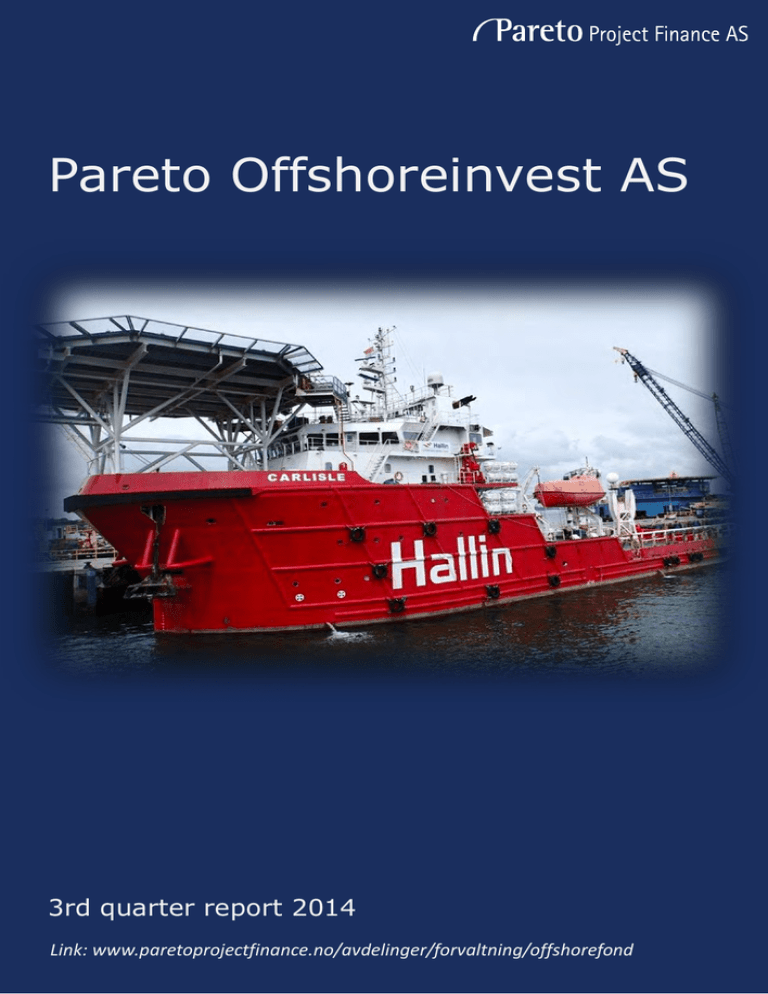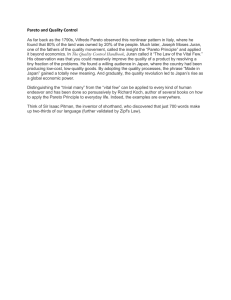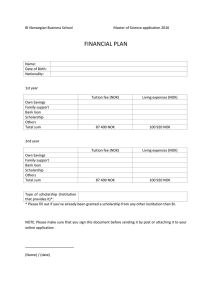Pareto Offshoreinvest AS
advertisement

Pareto Offshoreinvest AS 3rd quarter report 2014 Link: www.paretoprojectfinance.no/avdelinger/forvaltning/offshorefond Executive Summary NAV NOK 83/share (as of 30 June 2014, dividend adjusted) POI paid NOK 17 per share to its shareholders in August 2014 following project realizations. Adjusted for this, the NAV per share as of 30/6/14 is NOK 83 per share. The USD has strengthened significantly against the NOK, which will have a meaningful impact on the next NAV, which will be reported as of 31/12/14. The oil price collapse poses new challenges going forward, primarily on terms of project realizations, since a very high proportion of the portfolio continues to be on long term contracts. Market Development Portfolio Global commodity markets have sold off significantly this year, with oil the stand-out weak performer. Growing concerns about emerging market economic growth have coincided with renewed uncertainty about the Eurozone, the Ukraine crisis, the Ebola virus and a seasonally weak point in the oil market. The portfolio consist of shares in 11 projects with a total of 18 vessels. The 15% decline in the oil price seen in the past month will put an additional damper on already trimmed E&P budgets. As such, one should expect a negative development in oil services in the near term. The timing and scope of a potential rebound will depend on how quickly supply and demand forces respond. At the moment, an exposure to late cyclical segments is likely to be rewarded. The Fund’s exposure is generally more weighted to this theme and the portfolio is not expected to be dramatically effected. The contract coverage is 88% with a weighted contract length of 3.1 years. POI has distributed NOK 37 per share to its shareholders so far this year, taking total distributions since inception to NOK 55 per share (55% of par). Further distributions will depend on running dividends and project realizations. Portfolio News POI is invested in 11 offshore projects, which implies a good diversification across different market segments. This section provides an update on the quarter’s most important newsflow related to the underlying investments. Master and Commander IS Carlisle Subsea IS Both vessels are on charter and the charter hire is paid relatively punctually. The seismic market has generally weakened during the past six months. While CGG (charterer of Phoenix) is struggling to employ their fleet, Fairfield Nodal (charterer of Commander) appears to have found a profitable market for their niche technology (ocean bottom seismic). Discussions to restructure the Phoenix CP has been initiated, but this will only be considered at profitable terms for M&C. The charterer is being closed down by its owner, Superior Energy. It is unclear what this will result in, as charter hire is still paid punctually. However, a termination of the current arrangements and a sale of the vessel would represent a positive outcome for the project. Asian Offshore IS The average day rate for the four vessels was $ 7,200/d during Q3’14, down 8% on the preceding quarter. The project valuation has been revised down due to weak operational cash flow and final payments of this year’s drydockings. The integration process together with the partners AO III and ACS is still ongoing, but the efforts to secure a financing package have been hit by the financial market volatility. At the time of writing, it is therefore unclear whether the refinancing and integration can be completed in the near term. Vestland Seismic IS The vessel M/V Vikland is still idle and there have been no material developments regarding a new charter or a sale. The shareholders contributed USD 3.5m in uncalled capital during Q3’14 to retire all outstanding bank debt. The project is thus 100% equity. The seismic market is very weak and it will take time to secure a new employment for the vessel. PSV Invest II IS The vessel was on a 4-month contract with ConocoPhillips at above market day rates during Q3’14. It has just started on a 3+1+1 year contract with Apache Petroleum in the UK at a rate that implies a slightly lower contribution. However, it is hoped that this may pave the way for a re-negotiation of the financing terms for the project. Azur Offshore IS, 3B Offshore IS, Norseman Offshore IS, Far East Offshore IS. These projects are all developing according to schedule with charterers performing (hire paid punctually), debt serviced according to plan and free cash distributed to owners. Payments from projects During Q3’14, POI received dividend payments of NOK 0.2m. In addition, realization proceeds totalling NOK 12.0m was paid to POI in Q3’14. New investments POI has not made any new investments during Q3’14 and will refrain from doing so for the remainder of its lifetime, save for follow-up investments in existing projects, if required. During Q3’14, POI contributed NOK 1.2m of such investments. Portfolio Project / company Segment 3B Offshore IS PSV/AHTS (Europe) Master and Commander IS Seismic Carlisle Subsea IS Subsea PSV Invest II IS PSV/AHTS (Europe) Songa Offshore SE 2011/2016 FRN Semi Submersible Rig Azur Offshore IS PSV/AHTS (Asia) Asian Offshore IS PSV/AHTS (Asia) Vestland Seismic IS Seismic Norseman Offshore IS PSV/AHTS (Europe) Far East Offshore IS PSV/AHTS (Asia) PSV Invest II IS shareholder loan PSV/AHTS (Europe) Charterparty Distribution based on NAV Bareboat 68% Charterer Nov-17 Aug-18 Oct-15 Oct-17 May-18 Jun-23 Bourbon CGG/Fairfield Nodal Hallin Marine Subsea Conoco Songa Offshore SE Ezra Holdings Dec-20 Feb-17 Nov-17 Bareboat Bareboat Bareboat Timecharter High yield bond Bareboat Spot/Asset play Spot/Asset play Bareboat Bareboat Timecharter Albatross Shipping Viking Supply Ships AS Sanko Steamship Ltd Maersk Oil 27.4 22.9 14.8 11.9 8.8 8.7 8.4 7.0 6.8 6.4 4.3 Subsea 12% Seismic 23% Semi Submersible Rig 7% PSV/AHTS (Asia) 19% Spot/Asset Play 12% High yield bond 7% % % % % % % % % % % % Segment Distribution based on NAV PSV/AHTS (Europe) 39% Timecharter 13% Proportion of NAV Contract Charterparty Second Hand Market and Liquidity As of 30.09.2014 POI had 851,877 shares outstanding. Pareto Project Finance AS (”PPF”) aims to facilitate an active second hand market for shares. The last trading price was NOK 65 per share. This transaction was concluded following the latest distribution of NOK 17 per share in August, which means that the trading price was flat from the previous transaction adjusted for the distribution.. Investors who wish to buy or sell shares should contact their advisors or alternatively PPF directly. Last 5 trades in second hand market Date Share price No. of shares Volume (NOK) 18/02/14 75 894 67,050 25/06/14 78 4,389 342,342 06/08/14 82 5,000 410,000 06/08/14 82 4,129 338,578 18/08/14 65 1,000 65,000 Number of trades since establishment 41 Volume traded since establishment (NOK) 7,846,773 Average volume per trade (NOK) 125 2,000 Pareto Offshoreinvest AS - Second Hand Trades Volume (Thousand NOK) NAV per share NAV per share (dividend adjusted) Second hand price per share 1,800 1,600 1,400 100 1,200 Price per share 83 75 1,000 65 50 800 600 400 25 200 0 Dec-08 Jun-09 Dec-09 Jun-10 Dec-10 Jun-11 Dec-11 Jun-12 Dec-12 Jun-13 Dec-13 Jun-14 Date 0 Volume (Thousand NOK) 150 191,385 The offshore oil services market The dust has settled after panic hit the financial markets last month, resulting in a broad commodity sell-off. Global economic growth expectations have been lowered, both for emerging markets and the Euro zone. This has coincided with a sharp rise in the USD, an abundance of crude in the market in a seasonally weak period of the year and thus a rather dramatic plunge in the oil price. What is next? Global Commodity Prices, YTD performance Doom and gloom in oil The rather sluggish seaborne trading volumes in shipping during the past year have lead us to question the real growth in the global economy. It seems as if the global financial markets have finally caught up, hung over from a multi-year QE-intoxication. The sentiment has been worsened by the Ukraine crisis, Ebola and tensions in Syria and Iraq. The oil price has taken a severe beating, but appears part of a general commodities sell-off. As such, one may explain the weakness as being driven by growth concerns in emerging economies, particularly China. Source: Bloomberg, Nasdaq, LME Brent Crude, $/bbl The reasons why oil has fared worse than other commodities include a strengthening USD, a sharp growth in US tight oil production, seasonally weak markets and growing oil inventories. Where do we go from here? If global growth indeed turns out on the low side, the oil industry must adapt to lower demand growth. With the growth in non-OPEC production, driven by US tight oil, set to continue, this implies a new reality for OPEC, which will have to cut back production for the first time since 2011. The fact that Saudi Arabia so far has cut prices instead of volumes has attracted significant attention. One key reason may be that the strengthening USD results in a limited margin Source: Nordea impact as its costs are primarily non-USD denominated. Assuming a stable, strong USD, some oil market analysts have therefore pointed to USD 90/b as being the new USD 100/b for the Saudis. Others believe that Saudi Arabia is out to test the real break-even levels for US tight oil to see where the pain level lies, i.e. where drilling is cut back and production growth abates. No one really knows, the answer to this, but probably we will have to see WTI prices well below $80/b for an impact. Nevertheless, market dynamics generally work. We expect to see the supply side react to the sell-off in oil. At some point in the next three months, we would expect to see OPEC reduce quotas (the next OPEC meeting is 27 November). We would also expect to see some of the higher cost US tight oil impacted. The sharp contango in oil prices would also encourage inventory build, taking volumes off the physical market. Demand is also heading into seasonally stronger territory and should reduce the overhang. We see the overall situation as markedly different to the 2009 bottomed at USD 35/b. set-up when oil Underlying fundamentals prices could therefore stage a recovery in oil prices near term. However, it may be some time before we visit triple digit territory again. And for those worrying about global economic growth, let us not forget that lower energy prices provide a very meaningful stimulus in its own right. Source: Nordea Oil services, continued Expect further pressure on E&P spending The oil majors`cut backs in E&P spending budgets have been well publicised, but is likely be higher with a weaker oil price. Hence, overall market growth will be weaker than assumed only a few months ago. Lower oil prices will also spread across to independents and NJOCs. The former are generally more exploration oriented and may experience lower access to funding. The NOCs should in principle represent more stability. The most recent forecasts indicate roughly 5% decline in global E&P spending in 2015, predicated on a modest oil price recovery. Indeed, we’ve seen the first major oil companies announce budget reductions in line with this. Source: Pareto Securities A weak sentiment and will inspire all players to reduce risk through securing backlogs by sacrificing pricing. Hence, most segments should experience negative pricing development. We have already seen this in the rig market, where available rigs are being re-contracted at significant discounts to previous rate levels. In this part of oil services, there is the added problem of a large newbuild order book, which will have an unfavourable impact on the market balance. The seismic market has followed exploration spending down this year. Volumes are lower, but pricing is holding up reasonably well. One benefit of this market is that it is well consolidated and the large players have already initiated both permanent and temporary capacity retirement. This will cushion the downturn and means that it may not become quite as bad as many appear to fear. Source: Pareto Securities In the offshore support vessel space, the situation is mixed. The North Sea markets have been very volatile this year. The main headline has been lower demand from Statoil, but some of the slack appears to have been picked up by others as the Q3 activity has been quite buyoant, particularly for AHTS. Nonetheless, nobody seems to believe in better markets next year. Elsewhere, Brazil is improving and several long term contracts have been renewed, with additional vessel requirements coming to the market. The West African market is also reasonably strong. It continues to be driven by production development work, which was sanctioned by the oil companies years ago and currently subject to large field development Source: Seabrokers contracts coming to the execution phase. The Asian market remains choppy and appears the one most directly linked to the movements in the oil price. The subsea markets are generally late cyclical and the main SURF players have record high order books to execute in the coming years. Hence, the baseload of work should be healthy. On the other hand, shorter term and more maintenance driven work is likely to be impacted and will reduce overall fleet utilization and rates. If the oil price stays low, the main impact will be felt in a 3-5 year perspective through fewer field developments. Fund Management Team Richard Jansen Head of Fund Management Shipping/Offshore Phone: + 47 22 01 58 96 E-email: richard.jansen@pareto.no Patrick Kartevoll Fund Manager Shipping/Offshore Phone: + 47 22 01 58 79 E-mail: patrick@pareto.no Dronning Mauds Gate 3, P.O. Box 1396 Vika, NO-0114 Oslo, Norway, Tlf: 22 87 87 00, www.pareto.no Disclaimer This Quarterly Report has been prepared in order to provide information about Pareto Offshoreinvest AS (“POI” or the “Company”) and must not be considered an offer to trade in the shares of the Company. development. All investors must verify these assumptions themselves. The company cannot give any assurance as to the correctness of such information and statements. Information contained in this Quarterly Report is obtained by Pareto Project Finance AS (“Pareto Project Finance”, “Pareto”, or “PPF”). Information is presented to the best of our efforts and knowledge, but Pareto Project Finance AS cannot guarantee that the information is correct or all inclusive. Pareto Project Finance AS takes no responsibility for any loss caused by information given being misleading, wrongful or incomplete nor for any other loss suffered as a consequence of investments made in the Company. Historic returns and return forecasts do not constitute any guarantee for future returns. Returns may vary as a consequence of fluctuations in currency exchange rates. Investors should be aware that there is significant uncertainty related to valuations in the current volatile market. The valuation process is described in PPF’s market report as per November 2014. Risks and costs are further described in the prospectus (information memorandum) produced in relation to share issues in the Company. This Quarterly Report includes and is based on, among other things, forward-looking information and statements. Such forward-looking information and statements are based on the current expectations, estimates and projection of the company or assumptions based on information available to the company and Pareto Project Finance AS. Such forwardlooking information and statements reflect current views with respect to future events and are subject to risks, uncertainties and assumptions that may cause actual events to differ materially from any anticipated The contents of this presentation are not to be construed as legal, business, investment or tax advice. Each recipient should consult with its legal-, business-, investment-, and tax advisors as to legal, business, investment and tax advice. Specifically, Pareto Project Finance AS has been engaged as the company’s financial advisor and does not render – and shall not be deemed to render – any advice or recommendations as to a transaction.



